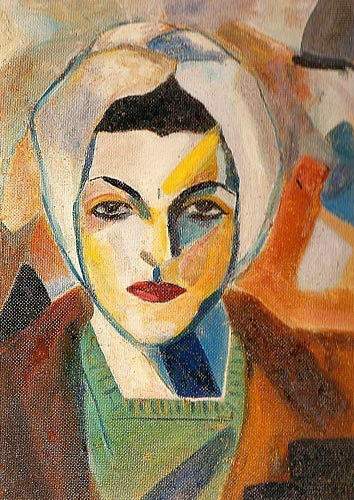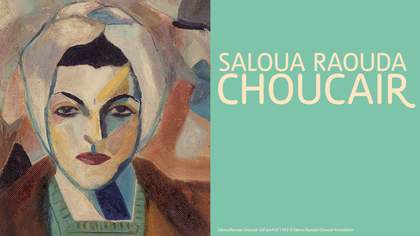
Saloua Raouda Choucair
Self Portrait 1943
© Saloua Raouda Choucair Foundation
Saloua Raouda Choucair is one of the most respected living artists in Lebanon, though her work is little known outside of her home country.
She was born in Beirut in 1916. She learnt to draw and paint under the tutelage of Omar Onsi and Moustafa Farroukh, prominent Lebanese artists who adopted impressionist and realist styles. A trip to Egypt in 1943 sparked her passion for Islamic art and architecture and her conviction – despite the beliefs of her tutors – that Arab artists ‘reached into the essence of the subject, stripping it of all the associated with art since the time of the Greeks until the end of the 19th century.’
At the end of the 1940s Choucair spent three important years in Paris where she absorbed the current themes, trends and philosophies of European modernism. Though she was a student at the École des Beaux-Arts and attended the studio of the master Fernand Léger, Choucair found like-minded individuals at the Atelier d’Art Abstrait, a group of artists committed to the pursuit of abstract or non-objective art. The exhibition at Tate Modern begins with a group of vibrant gouache paintings from this period, showing the artist’s experiments with repeated, modular forms inspired by her love of geometry and mathematics.
In the late 1950s, working from her home studio in Beirut, Choucair began modelling in clay and carving wood. Her first series of sculptures explores the trajectory of a line. Choucair was interested in the ability of a line to follow a path that allows it to transform itself into numerous shapes. The line and curve are basic elements of the visual language that she used throughout her career, finding its way into a variety of media including painting, sculpture, textiles, murals and other domestic designs.
In the 1960s she worked on a series known as ‘interforms’; simple cubes or blocks housing intricately carved, complex internal forms. This was followed by the series she later titled ‘poems’, modular sculptures with parts that stack together in a flexible way. Each module, like the stanzas of Arabic poetry, may stand alone or be stacked with others to be read as a whole. A further group of works are known as the ‘duals’, having two interlocking parts.
Choucair’s ideas are often worked out across various materials, and forms from her early paintings are repeated in later sculptures and in other items she made to express her belief that art should be a living, architectural reality. The exhibition brings groups of these works together, showing the rich and complex connections between pieces and exploring the artist’s belief in the power of non-objective art. An extensive display of small maquettes that Choucair made throughout her career shows fascinating ‘studies’ that reveal the artist’s impressive creative energy. One of her modular paintings from the late 1940s was pierced by shards of shattered glass in the artist’s apartment during a bombing raid in the Lebanese civil war of the 1980s. The object bears witness to that history and the circumstances through which Choucair not only survived, but continued to work with energy and enthusiasm.
The final room showcases a group of experimental sculptures from the 1980s made of aluminium, plexiglass and nylon thread that relate to Choucair’s ambitions to incorporate water and movement into her works.
Throughout the 1980s and 90s Choucair received increasing recognition and awards for her work. In 1982 she was commissioned by the Lebanese Lions Club to create a major public sculpture. The piece was installed at the southern entrance to Beirut, but was vandalised and then disappeared completely. Choucair went on to complete further commissions in the 1990s, one of which now stands at the Gibran Khalil Gibran Garden in downtown Beirut.
In 2011 a major retrospective of her work was held at the Beirut Exhibition Center. Choucair is now in her 96th year and her daughter is working on the establishment of her Foundation. The curators of the exhibition, Jessica Morgan and Ann Coxon, were given access to Choucair’s archive and the substantial body of work that remains in her Beirut apartment. This is the first opportunity to see a broad and fascinating selection of works by Saloua Raouda Choucair finally taking their place in a museum of international modern art.

